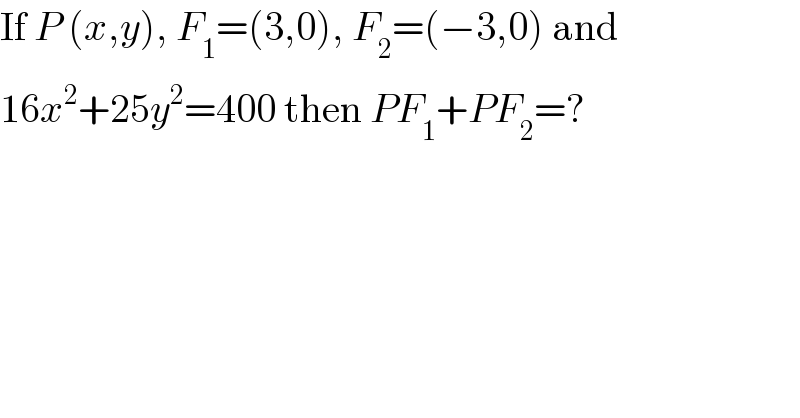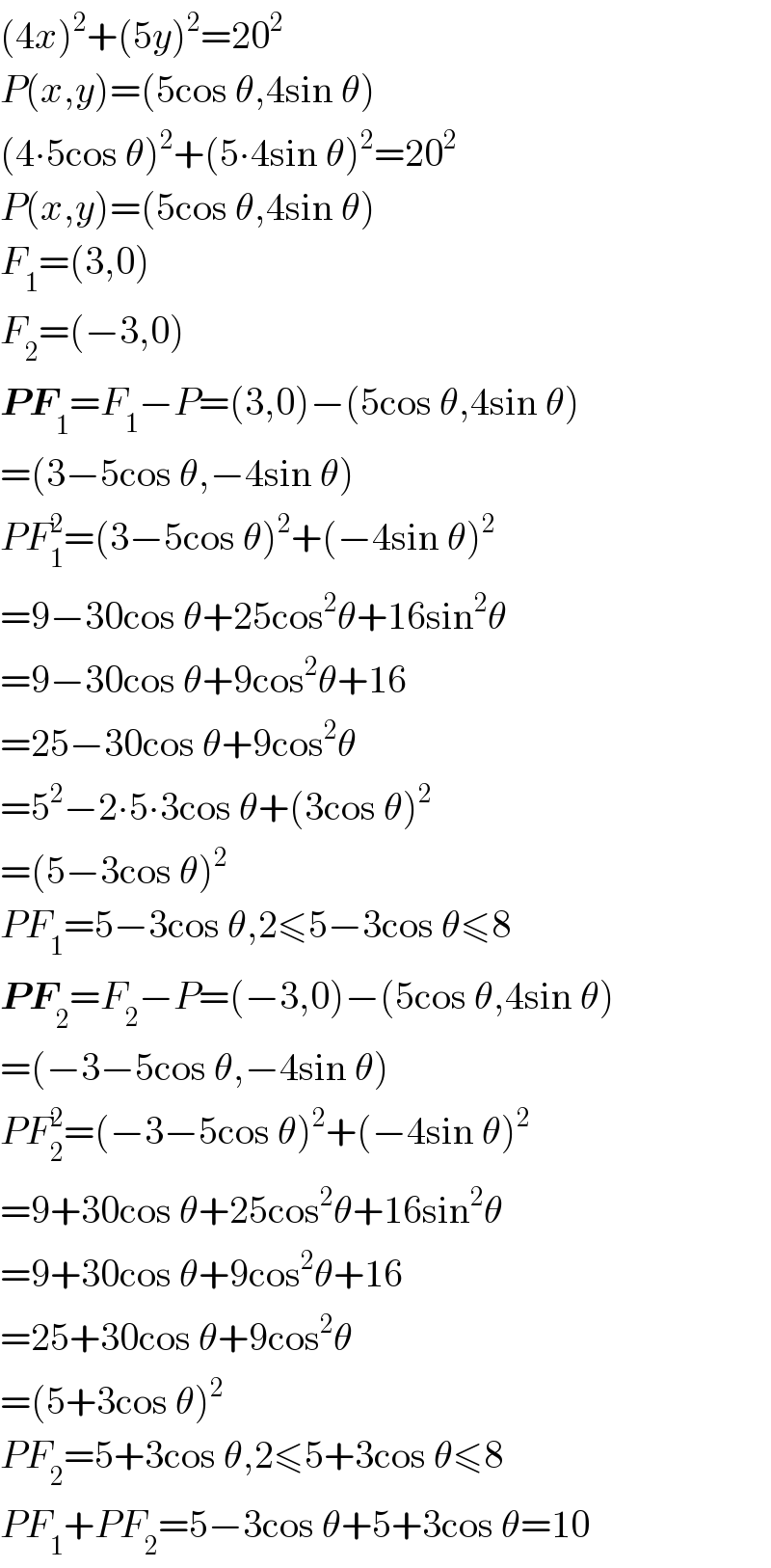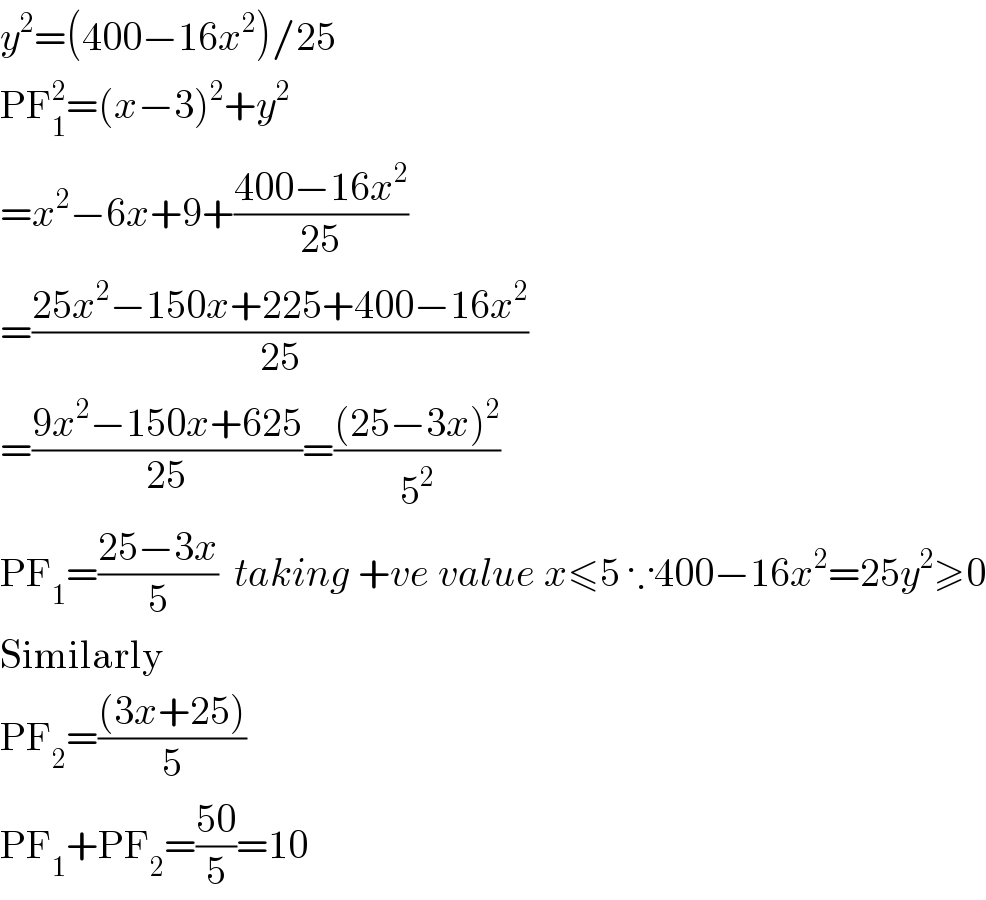
Question Number 279 by amandeep last updated on 25/Jan/15

$$\mathrm{If}\:{P}\:\left({x},{y}\right),\:{F}_{\mathrm{1}} =\left(\mathrm{3},\mathrm{0}\right),\:{F}_{\mathrm{2}} =\left(−\mathrm{3},\mathrm{0}\right)\:\mathrm{and}\: \\ $$$$\mathrm{16}{x}^{\mathrm{2}} +\mathrm{25}{y}^{\mathrm{2}} =\mathrm{400}\:\mathrm{then}\:{PF}_{\mathrm{1}} +{PF}_{\mathrm{2}} =? \\ $$
Answered by 123456 last updated on 18/Dec/14

$$\left(\mathrm{4}{x}\right)^{\mathrm{2}} +\left(\mathrm{5}{y}\right)^{\mathrm{2}} =\mathrm{20}^{\mathrm{2}} \\ $$$${P}\left({x},{y}\right)=\left(\mathrm{5cos}\:\theta,\mathrm{4sin}\:\theta\right) \\ $$$$\left(\mathrm{4}\centerdot\mathrm{5cos}\:\theta\right)^{\mathrm{2}} +\left(\mathrm{5}\centerdot\mathrm{4sin}\:\theta\right)^{\mathrm{2}} =\mathrm{20}^{\mathrm{2}} \\ $$$${P}\left({x},{y}\right)=\left(\mathrm{5cos}\:\theta,\mathrm{4sin}\:\theta\right) \\ $$$${F}_{\mathrm{1}} =\left(\mathrm{3},\mathrm{0}\right) \\ $$$${F}_{\mathrm{2}} =\left(−\mathrm{3},\mathrm{0}\right) \\ $$$$\boldsymbol{{PF}}_{\mathrm{1}} ={F}_{\mathrm{1}} −{P}=\left(\mathrm{3},\mathrm{0}\right)−\left(\mathrm{5cos}\:\theta,\mathrm{4sin}\:\theta\right) \\ $$$$=\left(\mathrm{3}−\mathrm{5cos}\:\theta,−\mathrm{4sin}\:\theta\right) \\ $$$${PF}_{\mathrm{1}} ^{\mathrm{2}} =\left(\mathrm{3}−\mathrm{5cos}\:\theta\right)^{\mathrm{2}} +\left(−\mathrm{4sin}\:\theta\right)^{\mathrm{2}} \\ $$$$=\mathrm{9}−\mathrm{30cos}\:\theta+\mathrm{25cos}^{\mathrm{2}} \theta+\mathrm{16sin}^{\mathrm{2}} \theta \\ $$$$=\mathrm{9}−\mathrm{30cos}\:\theta+\mathrm{9cos}^{\mathrm{2}} \theta+\mathrm{16} \\ $$$$=\mathrm{25}−\mathrm{30cos}\:\theta+\mathrm{9cos}^{\mathrm{2}} \theta \\ $$$$=\mathrm{5}^{\mathrm{2}} −\mathrm{2}\centerdot\mathrm{5}\centerdot\mathrm{3cos}\:\theta+\left(\mathrm{3cos}\:\theta\right)^{\mathrm{2}} \\ $$$$=\left(\mathrm{5}−\mathrm{3cos}\:\theta\right)^{\mathrm{2}} \\ $$$${PF}_{\mathrm{1}} =\mathrm{5}−\mathrm{3cos}\:\theta,\mathrm{2}\leqslant\mathrm{5}−\mathrm{3cos}\:\theta\leqslant\mathrm{8} \\ $$$$\boldsymbol{{PF}}_{\mathrm{2}} ={F}_{\mathrm{2}} −{P}=\left(−\mathrm{3},\mathrm{0}\right)−\left(\mathrm{5cos}\:\theta,\mathrm{4sin}\:\theta\right) \\ $$$$=\left(−\mathrm{3}−\mathrm{5cos}\:\theta,−\mathrm{4sin}\:\theta\right) \\ $$$${PF}_{\mathrm{2}} ^{\mathrm{2}} =\left(−\mathrm{3}−\mathrm{5cos}\:\theta\right)^{\mathrm{2}} +\left(−\mathrm{4sin}\:\theta\right)^{\mathrm{2}} \\ $$$$=\mathrm{9}+\mathrm{30cos}\:\theta+\mathrm{25cos}^{\mathrm{2}} \theta+\mathrm{16sin}^{\mathrm{2}} \theta \\ $$$$=\mathrm{9}+\mathrm{30cos}\:\theta+\mathrm{9cos}^{\mathrm{2}} \theta+\mathrm{16} \\ $$$$=\mathrm{25}+\mathrm{30cos}\:\theta+\mathrm{9cos}^{\mathrm{2}} \theta \\ $$$$=\left(\mathrm{5}+\mathrm{3cos}\:\theta\right)^{\mathrm{2}} \\ $$$${PF}_{\mathrm{2}} =\mathrm{5}+\mathrm{3cos}\:\theta,\mathrm{2}\leqslant\mathrm{5}+\mathrm{3cos}\:\theta\leqslant\mathrm{8} \\ $$$${PF}_{\mathrm{1}} +{PF}_{\mathrm{2}} =\mathrm{5}−\mathrm{3cos}\:\theta+\mathrm{5}+\mathrm{3cos}\:\theta=\mathrm{10} \\ $$
Commented by 123456 last updated on 18/Dec/14

$$\boldsymbol{\mathfrak{f}}\mathfrak{ixed} \\ $$$$\mathrm{thank}\:\mathrm{you}. \\ $$
Commented by prakash jain last updated on 18/Dec/14

$$\mathrm{In}\:\mathrm{step} \\ $$$$\mathrm{PF}_{\mathrm{1}} ^{\mathrm{2}} =\left(\mathrm{3}−\mathrm{5cos}\:\theta\right)^{\mathrm{2}} +\left(−\mathrm{4sin}\:\theta\right)^{\mathrm{2}} \\ $$$$\mathrm{It}\:\mathrm{is}\:\mathrm{actually}\:\mathrm{PF}_{\mathrm{1}} ^{\mathrm{2}} \:\mathrm{and}\:\mathrm{not}\:\mathrm{PF}_{\mathrm{1}} \\ $$
Answered by prakash jain last updated on 18/Dec/14

$${y}^{\mathrm{2}} =\left(\mathrm{400}−\mathrm{16}{x}^{\mathrm{2}} \right)/\mathrm{25} \\ $$$$\mathrm{PF}_{\mathrm{1}} ^{\mathrm{2}} =\left({x}−\mathrm{3}\right)^{\mathrm{2}} +{y}^{\mathrm{2}} \\ $$$$={x}^{\mathrm{2}} −\mathrm{6}{x}+\mathrm{9}+\frac{\mathrm{400}−\mathrm{16}{x}^{\mathrm{2}} }{\mathrm{25}} \\ $$$$=\frac{\mathrm{25}{x}^{\mathrm{2}} −\mathrm{150}{x}+\mathrm{225}+\mathrm{400}−\mathrm{16}{x}^{\mathrm{2}} }{\mathrm{25}} \\ $$$$=\frac{\mathrm{9}{x}^{\mathrm{2}} −\mathrm{150}{x}+\mathrm{625}}{\mathrm{25}}=\frac{\left(\mathrm{25}−\mathrm{3}{x}\right)^{\mathrm{2}} }{\mathrm{5}^{\mathrm{2}} } \\ $$$$\mathrm{PF}_{\mathrm{1}} =\frac{\mathrm{25}−\mathrm{3}{x}}{\mathrm{5}}\:\:{taking}\:+{ve}\:{value}\:{x}\leqslant\mathrm{5}\:\because\mathrm{400}−\mathrm{16}{x}^{\mathrm{2}} =\mathrm{25}{y}^{\mathrm{2}} \geqslant\mathrm{0} \\ $$$$\mathrm{Similarly} \\ $$$$\mathrm{PF}_{\mathrm{2}} =\frac{\left(\mathrm{3}{x}+\mathrm{25}\right)}{\mathrm{5}} \\ $$$$\mathrm{PF}_{\mathrm{1}} +\mathrm{PF}_{\mathrm{2}} =\frac{\mathrm{50}}{\mathrm{5}}=\mathrm{10} \\ $$
